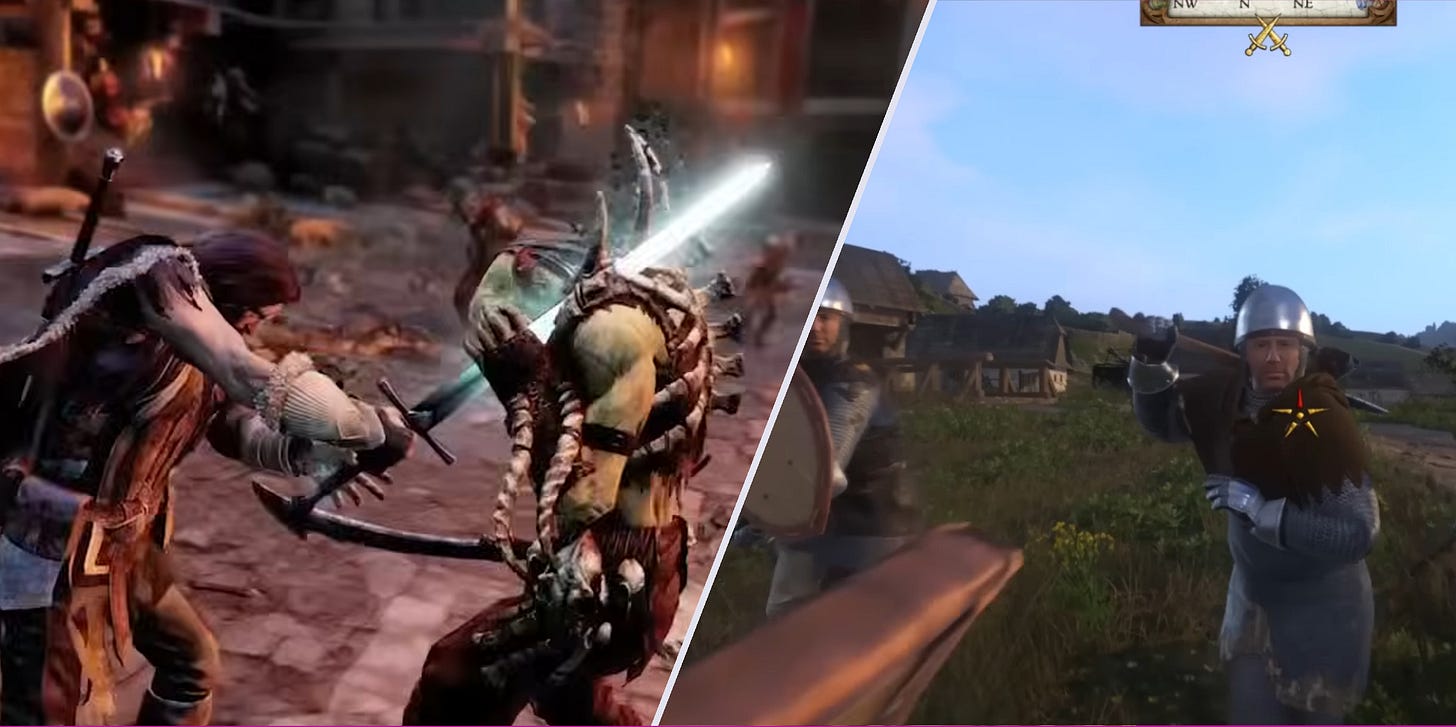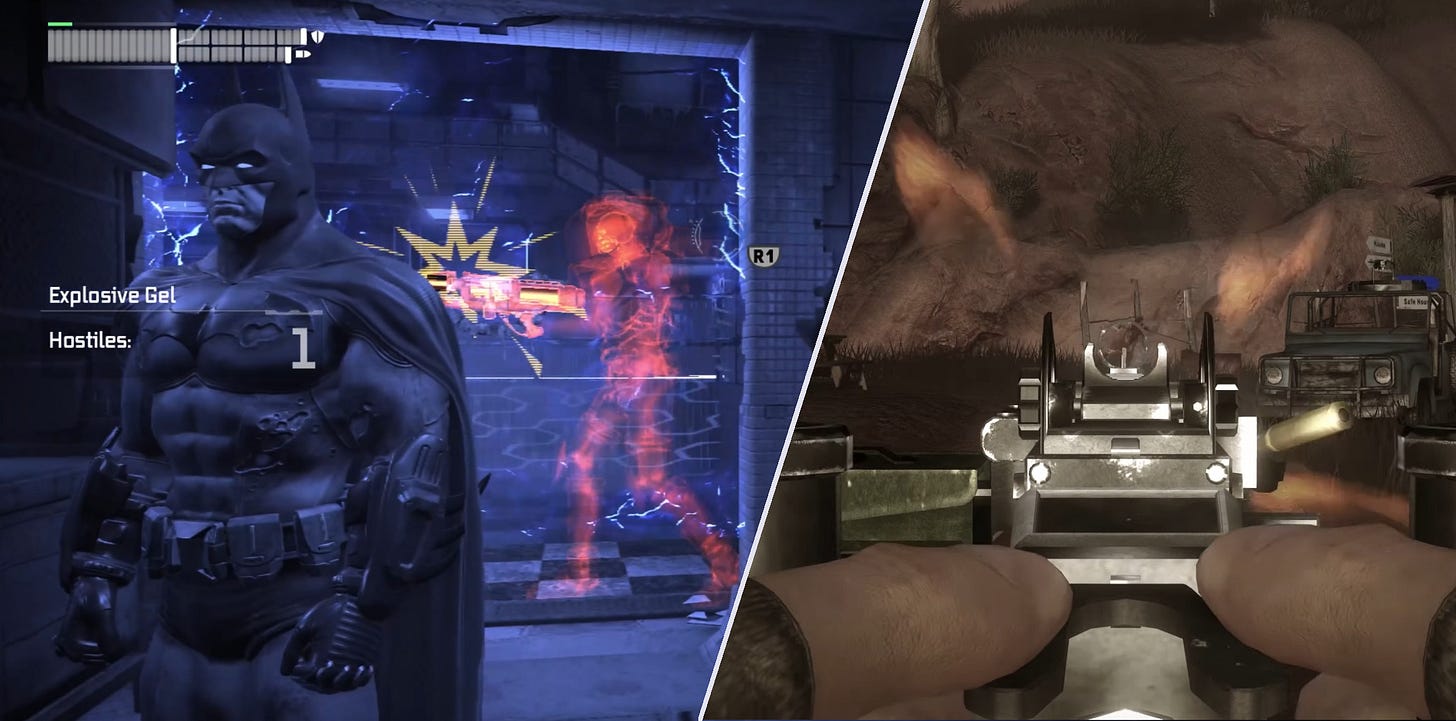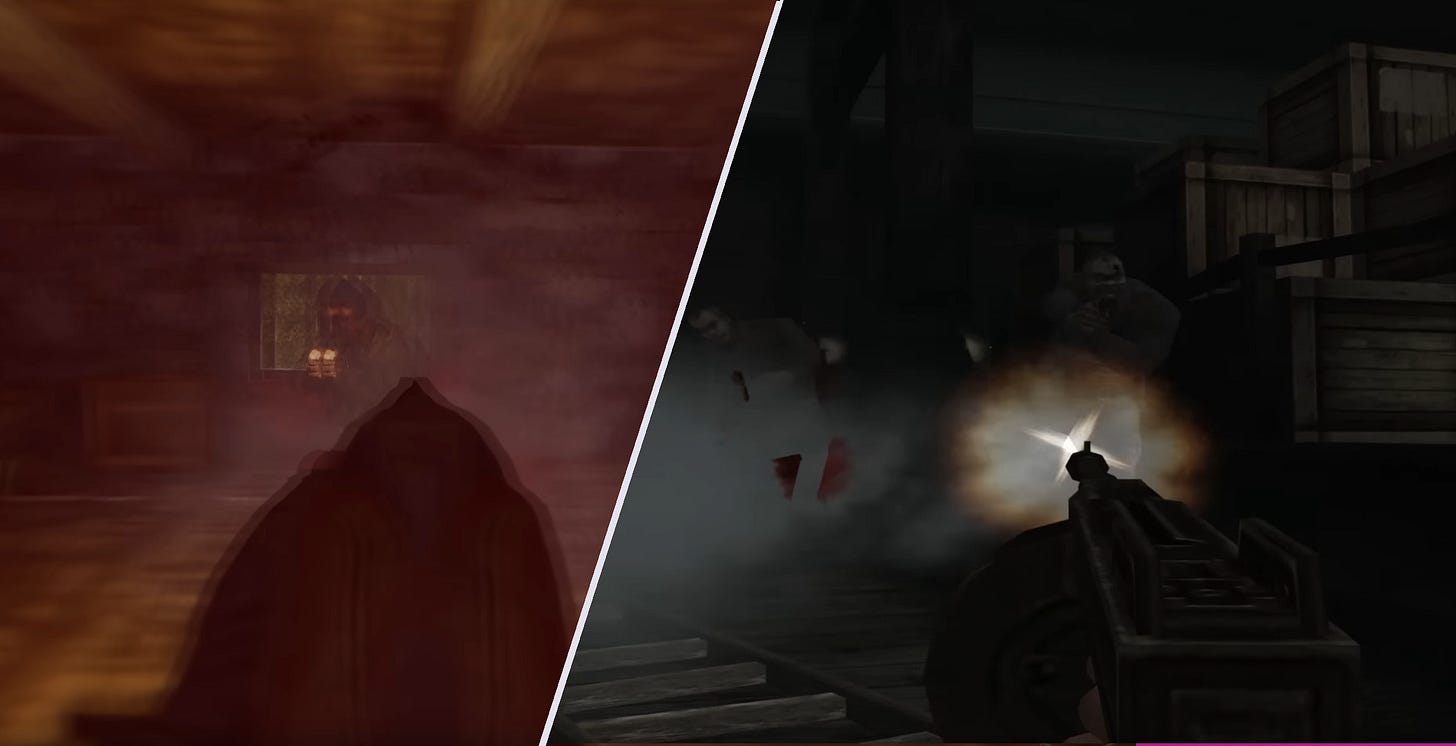Three Pillars of Quality Video Game Violence
The best combat systems go beyond simulating reality.
CONTAINING OUR BLOODLUST
For nearly as long as video games have existed, a bunch of pasty, noodle-armed computer nerds have sought to digitize the experience of violent conflict for the amusement of the sedentary masses. Centuries removed from the reliable catharsis of gladiatorial killing, said masses had grown fat on the lucre of post-war liberalism and were thus enthusiastic for every opportunity to simulate on a screen what they had lost in their Stepford reality of civil arbitration. I suppose that’s why the very first video game to see distribution beyond the device on which it was programmed was 1962’s Spacewar!, in which two players control a spaceship each and attempt to turn one another into diffuse clouds of viscera floating in the unforgiving void of unspecified space.
Now, six decades and countless thousands of commercial releases later, I think it’s fair to say that violent combat is the foremost conceit of most video games. Where the contemporary market is concerned, virtually every entry on any list of top-selling video games is either a simulation of war or a simulation of gridiron football (which in any case is just gladiatorial combat of a different sort). And in the 2010s, we got to a point where I believe we started to miss the forest for the trees somewhat. Publishers became less interested in projects with tight gameplay loops that satisfied the baser urges of their customers and accordingly obsessed with chasing utmost verisimilitude in their simulations of violence. That’s how we ended up with games like Squad, Escape from Tarkov, and Insurgency: Sandstorm whose overriding objective was to make the experience of shouting racial slurs over voice chat feel as similar as possible to literally participating in an armed conflict in which death might come at any moment.
Folks who’ve been reading for awhile will recall that, although I certainly respect the dedication and effort that went into projects like these, I’m not a big fan of the realism-first methodology as a driver of primary gameplay. My reasoning is pretty straightforward: while combat systems that painstakingly recreate the lumbering physicality and utmost fragility of the human warrior are often exhilarating, they’re seldom very much fun. Naturally, that begs the question of what I actually want out of a combat system in verisimilitude’s stead, and that’s what we’re going to discuss this week. I thought about it for awhile, and eventually realized that the combat systems I most adore have relatively little in common with one another at the level of primary gameplay but heaps upon heaps in common in their ground-level design considerations. I eventually arrived at these Three Pillars of Excellent Combat:
Responsiveness to input
Rewards for crafty thinking
Reflection of the game’s thematic inventory
Since at least a couple of these are relatively abstract, I figured it’d be useful to provide plenty of examples. So rather than trying to flail and gesture at what I have in mind, I’m going to cover each of these in turn with two examples each: one from a game I love that absolutely nails it, and one from a game deficient therein that I nevertheless enjoy. Hopefully, this veneer of positivity should offset my frequent celebrations of man’s inhumanity to man.
So, without further ado:
RESPONSIVENESS TO INPUT
BEST IN CLASS: Middle-earth: Shadow of Mordor
If you caught me at a jog, I’d probably call Shadow of Mordor my favorite third-person action game of all time, and around ninety percent of that adulation comes from how thoroughly it nails the connection between my input and the player character’s actions. The rules are simple: press the attack button, and Talion of Gondor will attack on the very next frame as long as he’s not staggered. Press the block button, and he’ll immediately transition into his parrying animation as long as there’s an incoming attack. Screw up and miss a prompt, and some hateful monstrosity will clock you in the jaw with the pommel of its sword or crush you with the business end of a scaly appendage.
What makes it work better than any other game of its kind is the Monolith engine’s revolutionary animation system. Talion can transition into a parry or a dodge-roll almost instantaneously, and this enables skilled players to fight upwards of a dozen slimy Uruks at once as long as their reflexes are on point. The game furnishes you with any number of tools by which to avoid or escape situations like that, but every time I replay the thing, I invariably find myself deliberately provoking a chaotic melee just to immerse myself in the soothing rhythm of steel crashing against steel and skulls crashing against pavement. And once you’ve done enough damage to go One Ring mode on the stinking bastards, Talion will cleave them from skullcap to crotch about as quickly as you can smash the “execute” combo.

ROOM FOR IMPROVEMENT: Kingdom Come: Deliverance
That’s right, I officially like KCD now. As it turns out, enjoying the thing really wasn’t any more complicated than doing a little research in order to meet the game on its level. That’s not to say that changing my opinion was uncomplicated, and it’s taken more effort than I’m usually prepared to extend to an RPG of this kind. But I’m happy to say that it eventually clicked after I’d spent twenty minutes wailing on Captain Bernard to boost my combat stats and a half-hour poaching rabbits to shore up my marksmanship, admiring the lush forests of modern Czechia all the while.
What hasn’t quite come together is the combat system, which I admire in principle but feel almost continuously aggrieved by in practice. And now that I’ve had another dozen hours back in the literal saddle, I can say with confidence that almost all my problems with the combat could be resolved if there were a greater correspondence between my button-presses and Henry’s actions. There’s a palpable, agonizing delay between making an attack input and the attack actually taking place as the game eagerly simulates the backswing and the follow-through, and that’s to say nothing of the perplexing unreliability of the camera lock or the stiffness of drawing a weapon in the first place. Fighting more than one enemy at a time is a universally miserable ordeal for these reasons, so it’s quite tiresome that the campaign and the random events set up so many encounters of this kind. KCD is at its strongest when I’m gearing up for combat or enjoying the spoils of victory, but the actual fighting in between is the weak link for me.
MY CRAFTINESS REWARDED
BEST IN CLASS: Batman: Arkham City
The Batman: Arkham games are in many ways the spiritual predecessors to Shadow of Mordor with regard to their combat systems. 2009’s Arkham Asylum, for its part, pretty much invented the concept of smoothly transitioning into blocks and counter-attacks from any position mid-combat. But Rocksteady’s Batman games are so well loved not just because of their action-packed beat-’em-up combat sequences but because of how faithfully they simulate the experience of being motherfucking Batman. Specifically, I love how Arkham City in particular rewards me for thinking like the Caped Crusader. In fact, the most exhilarating sequences in this game by my estimation are those in which face-to-face combat is totally unnecessary.
The foundation of Arkham City’s primary gameplay is the stealth encounter, and I can’t name a game that does it better. Given Batman’s entire toolbelt of comic book ephemera, you can approach a given stealth challenge in any number of ways. Suspend a guy upside-down from a gargoyle as he passes underneath? Check. Destroy some weakened masonry as a frightened lowlife gingerly tiptoes past? Check. Hack a guy’s weapon so that it jams when he impotently tries to defend himself against the rubber-suited menace that just dropped in front of him? Double check. The cherry on top is how, as you thin a given herd of enemies from stealth, the ones that remain standing become gradually more terrified as their comrades cease to answer their radios. Sometimes they’ll start screaming incoherently and randomly discharging their weapons, overcome with the terrible knowledge that they’re probably next. I laugh my ass off every time.
I’ve also got to shout out the boss fight against Mr. Freeze, which is one of my favorite ever in that it actually requires the player to act craftily in order to succeed — once you damage him with a given ability, he’ll adapt on the fly and it won’t work on him again. It’s a boss fight as a final exam for everything the game’s taught you, and that’s how I prefer my boss encounters.

ROOM FOR IMPROVEMENT: Far Cry 2
I’ve played every Far Cry game up through Primal, and I find that the second one from 2008 is the only one I ever feel like revisiting. I struggle to identify precisely why, and will indeed have to write about it sometime, but I think it’s largely down to its absorbing sense of place. Every title after the second started leaning into goofiness and even outright comedy in its mission design and overall character, but FC2 really does make you feel like a jobbing mercenary who’s been stranded in a destabilized East African terror state from which only your wits can extricate you. Also, I think malaria is severely underrated as a means of limiting the protagonist in a narratively appropriate manner. They should add it to next year’s Madden.
But I don’t love the encounter design, such as it is. What most confuses me is that the game gives you a whole arsenal of special weapons and equipment to facilitate alternative playstyles, but not one of them is ever as practical or efficient as pointing a rifle at a guy’s head and pulling the trigger. The stealth system is for shit, even if you go out of your way to unlock the ghillie suit. There’s an emphasis on using fire to your advantage inamongst the dry brush of the African savanna, even including a straight-up revolutionary system for simulating fire’s spread, but it’s almost never worth considering in detail when you could just throw a grenade at an entrenched foe or indeed just run up and shoot him.
I at least prefer the combat system to Far Cries 3 through whichever we’re up to now, since the series’ tried-and-true strategy of breaking the difficulty curve with a silenced sniper rifle only becomes viable late into Act 2 rather than ten minutes after the opening cutscene. Give FC2 a try if you skipped it — I reckon it’s due for a critical reevaluation one of these days.
THEMATIC CONSISTENCY
BEST IN CLASS: S.T.A.L.K.E.R.: GAMMA
Regular readers will recall that I very suddenly burned several dozen hours on this legendary modpack for S.T.A.L.K.E.R.: Anomaly earlier this year, and for good reason. The first-person shooting is well and good, but hardly the most standout aspect of the GAMMA experience. What I most love about its combat is how absorbingly realistic it feels in the context of the game’s fiction. Let me explain.
GAMMA is by no means the most mechanically true-to-life shooter out there. On a moment-to-moment level, in fact, it plays closer to a Battlefield game than to a simulation-shooter like Escape from Tarkov or Squad. Combat is usually quite fast-paced and takes place at relatively short distances, so there’s really no need for an ultra-grounded simulation of ballistics or human momentum. Instead, GAMMA focuses on the psychological aspects of getting into regular gunfights as an unaccountable mercenary in an unregulated conflict zone: bullets crack past your ears or glance off your helmet and blur your vision. People shout increasingly confused and disorganized commands on their radios as their comrades fall around them. Once-stalwart killers scream in terror, cry out for mother, or just gurgle pathetically after you land a solid hit.
Put together, it’s tremendously successful at selling the fantasy of such brutal combat as it might actually take place in a warzone on which polite society had already given up. Even looting the fallen after a battle remains tense, since you never quite know what kind of desperate gopniks and/or horrifying mutants might be sizing you up from a distance while you pat down your quarry in search of diet sausage. That’s the Zone for you.

ROOM FOR IMPROVEMENT: Call of Cthulu: Dark Corners of the Earth
At first, I was going to begin this section by calling Dark Corners of the Earth one of my favorite horror games of all time. On reflection, I realized the truth of the matter is that its first half alone is probably my favorite first-person horror experience, and the rest of it is complete dogshit that I don’t generally bother to replay.
The reasons behind this become pretty straightforward when you read into the game’s development history: early on, it was going to be much more action-forward, and even had a selection of multiplayer deathmatch maps almost ready to go before that idea was mercifully canned late in the process. Consequently, the team had to make some hasty changes to bring the combat system closer in line with their psychologically horrifying disempowerment fantasy. But they already had a bunch of guns modeled and a bunch of first-person shooting logic written up, so they tried to meet halfway. The result is a game where you spend the first half under almost constant tension as you gradually uncover the rot beneath Innsmouth’s genteel exterior, and the second half gunning down dozens upon dozens of monsters who are hardly even spooky in light of your awesome firepower. It’s profoundly dissonant with the themes and the atmosphere that the game had, until that point, put so much effort into shoring up.
Still, I love that first half. You can get it for a song these days, so give it a try if you’re into first-person horror and have a little experience with wrangling ancient PC games on modern hardware.
There you have my Three Pillars of Excellent Combat. As usual, I’d love to hear from you if there’s anything you’d add or change, or if you’d just like to share your memories of any of the games above.
Also: are there any games you love in which combat plays absolutely no role whatsoever? Looking through my own libraries, I noted remarkably few favorites of mine that met that standard, and I’m wondering whether that’s a reflection of the games industry or of my own ignoble depravity. Could be both, I suppose, but we’ll leave that discussion for some other time.
Til next week <3



Happy to see Far Cry 2 mentioned.
Most people have only played Far Cry 3 and the formless Ubislop that followed, or played the first game back when it was a PC melter akin to Crysis; I absolutely love Far Cry 2, it's like a LiveLeak video come to life: like watching grainy Yugoslav war footage or shaky cam from an African region conflict, except you're playing it.
For quality combat I would always recommend Serious Sam series - it's always a good de-stress game for me, along the ridiculous comedy
But let's not forget the indie scene 😀, for which I would recommend One Finger Death Punch, which I mentioned in my Sharing Article :)
As for non combat, so many... I guess many of my Gamer Dad Reviews cover them 😜, my fav from them... A Short Hike, which is also Good Game Lobby's October Game of the Month :)